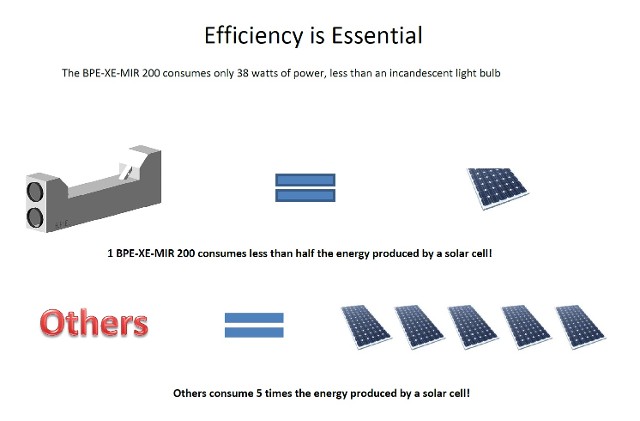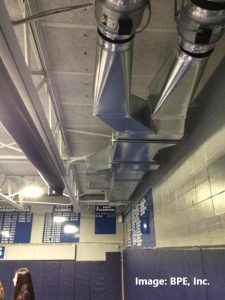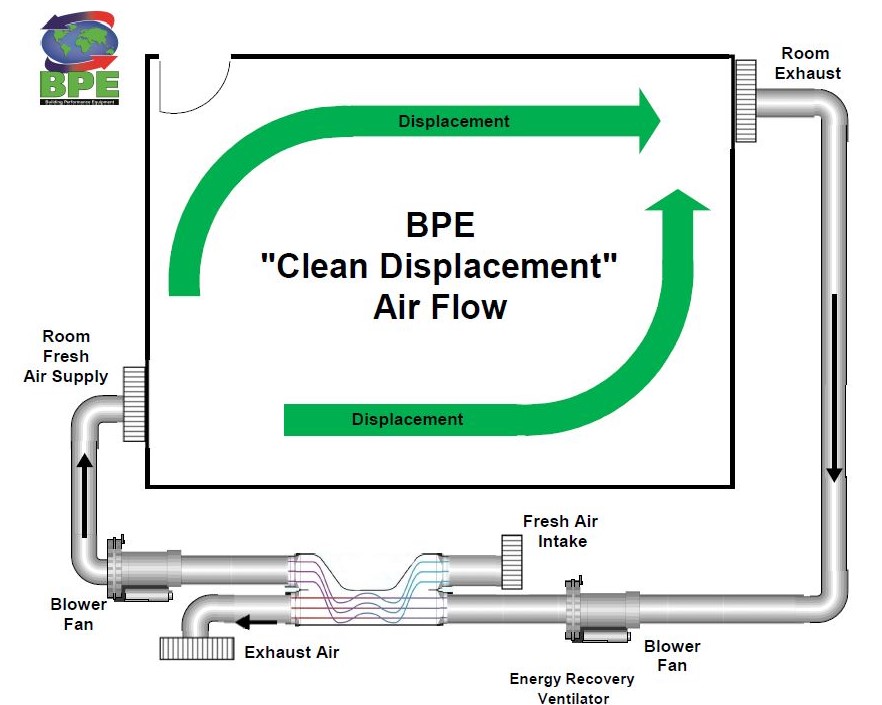Do you have an uncomfortable indoor air story in your past and perhaps your present? Sure, you do. Was it a stifling classroom in the heat of summer and a freezing one in winter? Did you fight a sleepy, lethargic malaise while taking a test in high school? As an adult, perhaps you suffered from Sick Building Syndrome in the ‘build it tighter than tight’ ’80s. Colds and stomach bugs, not to mention today’s viral scourge, can still spread through indoor environments like wildfire. And what excuses often come from building management when pressed to do something about it? Choose one or more of the following: aging HVAC equipment, easing the power budget, an oil shortage and rising oil prices, or taking part in a municipal event designed to save energy and thus, the planet. Of course, sometimes, the boss is just chilly, so the entire floor copes with a pumped up thermostat.
present? Sure, you do. Was it a stifling classroom in the heat of summer and a freezing one in winter? Did you fight a sleepy, lethargic malaise while taking a test in high school? As an adult, perhaps you suffered from Sick Building Syndrome in the ‘build it tighter than tight’ ’80s. Colds and stomach bugs, not to mention today’s viral scourge, can still spread through indoor environments like wildfire. And what excuses often come from building management when pressed to do something about it? Choose one or more of the following: aging HVAC equipment, easing the power budget, an oil shortage and rising oil prices, or taking part in a municipal event designed to save energy and thus, the planet. Of course, sometimes, the boss is just chilly, so the entire floor copes with a pumped up thermostat.
Worldwide, aging building stock and new builds that cut corners despite the need to build greener come with a heap load of HVAC weaknesses to unpack. Wouldn’t it be better to solve them all at once with an eye on the future?
The upfront cost of new equipment is likely a better bet than HVAC quick fixes over time.
HVAC discussions, complaints, and struggles have continued for over one hundred years. Must we battle them this much in 2022 after a pandemic illustrated the importance of superior ventilation better than ever before? How about after scientists noticed glaciers are melting faster than expected thanks to emissions from human activity in many sectors including buildings and construction?
If there is one thing the building industry should have learned by now, it’s that bandage fixes and money-saving hacks will not solve the multi-pronged dilemma of aging and/or inefficient HVAC. To achieve thermal comfort, healthy indoor air, defy pathogens, meet HVAC needs of the future, slash energy bills, and inflict less of an impact on the planet, it’s best to employ innovation that checks multiple boxes and typically pays for itself in two-to-three years of energy savings. It’s perfectly doable and may cost less than expected using the right technology.
School buildings are among the worst culprits for improper retrofits and skimpy HVAC.
Across America, schools figure among the worst of aging buildings even as they educate our future generations–who may struggle to learn effectively due to poor HVAC systems. That alone is cause for concern, but three years after the pandemic started, American parents still find themselves with worse worries over viral loads in classrooms and whether future surges could close unprepared schools again.
In Canada, provinces have earmarked funds to upgrade school ventilation. However, philosophies on how and where to spend the money differ across the country. Likewise, in the United States, where 41% of public schools have HVAC issues, some districts use their American Rescue Plan funds to implement high-efficiency equipment while others purchase independent HEPA filtration devices or electrostatic sprayers, choose bandage solutions, or simply turn to opening windows and doors more often.
As ongoing research discovers the long-term health effects of COVID–regardless of how sick an infected person felt–parental worries and the call for homogenous ventilation regulation is understandable. So, it’s no wonder that engineer and mom to two, Tracy Casavant, of Vancouver is fighting her school board for answers concerning air quality based on her own training. She wants access to authenticated documentation by a registered engineer that lays out the board’s decisions on ventilation and COVID-19 mitigation. “I would like the assurance from the proper professional that my building is safe,” she told CBC News. “And, I would like to know from a technical standpoint what ‘safe’ means.”
The board could not or would not produce the document, which is a requirement as part of regulatory codes. However, it claimed to follow guidance from the ministries of health and education and said the building’s HVAC equipment is, “set to bring in generous amounts of outdoor air as part of COVID preventable actions.” Still seeking the proper documentation, Casavant filed a complaint with Engineers and Geoscientists B.C. (EGBC) since the organization’s ethics code states engineers, “hold paramount the safety, health, and welfare of the public.” If that’s the case, Casavant believes engineers ought to be responsible for pathogen spread. And if not, who is liable? The question prompts yet another controversial discussion involving HVAC best practices for human health.
An HVAC bandage for mitigating SARS-CoV-2.
In the absence of uniform regulations, many Americans are taking indoor safety into their own hands by building Corsi-Rosenthal boxes. These DIY filtration systems are popping up in various buildings of concern but especially in schools. Parents, volunteers, and students have pitched in all over America (do a Twitter search, and you’ll come away quite inspired) to assemble four MERV-13 furnace filters, a sheet of cardboard, and a box fan with duct tape. The brainchild of Richard Corsi, dean of engineering at UC/Davis and Jim Rosenthal of Tex-Air Filters, these boxes effectively remove around 85% of the particulates that carry COVID-19.
These DIY filtration systems are popping up in various buildings of concern but especially in schools. Parents, volunteers, and students have pitched in all over America (do a Twitter search, and you’ll come away quite inspired) to assemble four MERV-13 furnace filters, a sheet of cardboard, and a box fan with duct tape. The brainchild of Richard Corsi, dean of engineering at UC/Davis and Jim Rosenthal of Tex-Air Filters, these boxes effectively remove around 85% of the particulates that carry COVID-19.
Caveat: Simply recirculating indoor air—even when filtered—just increases exposure to viruses and IAQ problems. The device also does not eliminate the need for the litany of other protective measures put in place throughout the pandemic. After all, no system will eradicate viral loads from indoor air 100%.
Depending on the materials used, one box can cost between $65 to $175 to make. They last around six months, and your average classroom will need at least one if not two. A bandage on a bigger problem? Of course, but if retrofitting to a high-efficiency HVAC system upgrade is simply not a budgetary option or taking too long, Mother Necessity, in the form of Corsi-Rosenthal boxes can help mitigate risk. Plus, constructing them brings people together through donations of time and money.
Still, that is lots of time, money, and expectation that folks will continue churning out boxes. Then there’s the matter of should they have to? When people spend their week working in an indoor office setting and they pay taxes into their kids’ school district, shouldn’t they have a right to expect a safe, comfortable environment without the need to become crafty with duct tape?
An all-encompassing solution to today’s HVAC dilemmas.
To pull a bunch of weeds with one yank, the most advantageous solution for upgraded HVAC or new builds is a high-efficiency Energy Recovery Ventilator (ERV) at the heart of a Dedicated Outdoor Air System (DOAS). Sound pricey? Let’s break down the reasons making the leap to an optimal system is worth the money—especially when it comes to schools:
Thermal Comfort: A high-efficiency (up to 90%+ thermal efficiency) ERV uses the heat energy already generated by furnaces, air\ conditioners, heat pumps, computers, and human activity to bring comfortable temperatures to indoor spaces. The outdoor heat of summer cools as a fan draws air into the building and through the ERV’s core. Likewise, in winter, cold air is drawn in warm and cozy. In extra-frigid zones, simply running the outdoor air supply through a heat pump first, the ERV can heat air further while improving indoor air quality. Humidity also comes under control. Comfortable people do better work.
Indoor Air Quality: Balanced mechanical ventilation by way of energy recovery brings in fresh air while eliminating (displacing as opposed to dispersing) stale, unhealthy air. Now consider this: ASHRAE recommends Standard 62.1 for exhausting and bringing in fresh air, but whether a building is meeting that goal, realize this is a minimum ventilation guideline, and there is talk about increasing it due to Covid and any future pathogens that spread easily. Will your current low-performance HVAC be up to the task? Upgrade effectively now for the future.
In addition to Covid transmission concerns, ‘clean sweep’ air exchanges reduce allergens and chemical particulates. Filters aid the process (Merv 7 and higher but check with an engineer to size them for your system). Adding a UV-C ultraviolent light system to sterilize your HVAC is another option, but typically used in medical settings.
Cost-Effectiveness: The amount of heating or cooling a building requires is its load. The better an ERV preconditions outside air, the less a load gets handled by other HVAC components such as air conditioners and furnaces. Processing a reduced load allows for smaller, less powerful HVAC components that cost less and last longer. In fact, at BPE, we’ve seen the implementation of an ERV achieve 80% thermal efficiency while keeping boilers from 1984 in service.
When it comes to replacing standard below-the-window ventilators in schools, each can cost up to $25,000 with installation. Now, if you bring outdoor air into a classroom through a BPE ERV, you’ll spend considerably less on upgrading that classroom. Having heard about engineering consult quotes of $3.5 million dollars for one wing of a school building, we know HVAC solutions that make a difference do not have to cost that much.
ERVs pretty much pay for themselves when you consider these points:
- The average small AC unit uses 500 watts of electricity while a smal
 ler ERV such as the BPE-XE-MIR-200i uses a mere 38 watts. The blower fans in traditional HVAC systems will always require more energy than the high-efficiency inline fans used by BPE’s ERV units.
ler ERV such as the BPE-XE-MIR-200i uses a mere 38 watts. The blower fans in traditional HVAC systems will always require more energy than the high-efficiency inline fans used by BPE’s ERV units. - Many ERV brands claim a payback period on units of within three years tops. (In our experience, BPE ERV customers typically enjoy that payback within two years thanks to the product line’s extra high thermal efficiency.
- For the rest of the system’s life (approximately 20 years for a BPE unit), customers enjoy a positive cash flow thanks to those lowered bills.
- Energy Efficiency Ratio (EER) is another consideration. This number is arrived at by dividing BTUs by the electrical watts used to generate airflow. The higher the EER, the less energy the device uses! (BPE units typically rate between 36 and 160 EER, while the HVAC industry averages 10 EER.)
- A high-efficiency ERV boasts a high rate of heat transfer. For your average ERV, this rate varies between 45% to 65% efficiency. We say that’s not good enough. BPE’s patented technology, used to create direct counterflow, fixed plate ERVs, achieves rates of 70% to over 90%.
- An ERV’s variable-speed controls can fine tune energy savings as well especially when programmable.
Emissions Reductions: Using less power and reusing heat energy makes ERV-based mechanical ventilation systems part of the global emissions solution instead of adding to the problem. Decarbonizing the atmosphere is vital to staving off a rate of global warming that may lower the quality of life for the same future generations we need to protect in schools through better ventilation. We suppose you could say, what comes around goes around.
At BPE, it’s not our place to decide who is liable for pathogen spread in buildings in Canada, the U.S., or anywhere else. We do, however, believe everyone from engineers, to contractors, to building owners and managers, school boards—you name it—bears an ethical responsibility to keep the health and well-being of our children, those working for us, people living in the structures we own, and the planet in mind when seeking solutions to today’s HVAC issues. We are privileged to have made homes, buildings, schools, and industrial complexes better stewards of the planet, net-zero, and even net-power producing through our ERV product line. (Please peruse some of our case studies and our ENERGY STAR® Success Story below.)
Contact BPE to discover the most cost-effective, all-encompassing HVAC solution for your property or school district. It’s time America stopped treating its building stock with quick, cheaper fixes and got serious about the present and the future.
stopped treating its building stock with quick, cheaper fixes and got serious about the present and the future.
BPE Case Studies:
Hunterdon Regional High School, N.J.
Hopewell Valley Regional School District
School ENERGY STAR® Success Story

